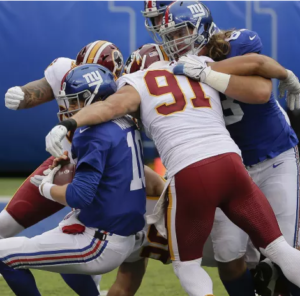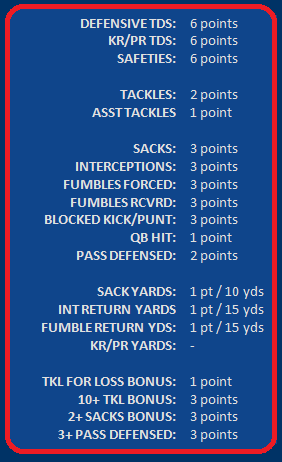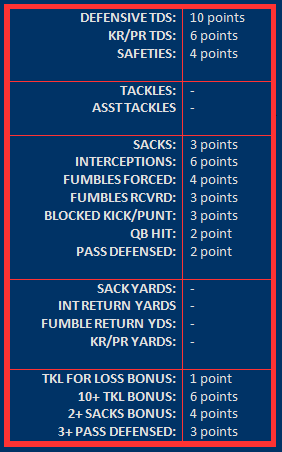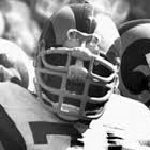Who’s Next? An Introduction to IDP Drafting
 So we all know that the household names in the football world are normally some of the highest producers in normal, offensive fantasy. However in IDP formats that is not always the case. The scoring system of the league, and what role a player plays in his team defense are key determinations for players on whether an IDP will be a stud or not in your league. This applies especially with DB’s, but in certain situations with DL’s and LB’s as well.
So we all know that the household names in the football world are normally some of the highest producers in normal, offensive fantasy. However in IDP formats that is not always the case. The scoring system of the league, and what role a player plays in his team defense are key determinations for players on whether an IDP will be a stud or not in your league. This applies especially with DB’s, but in certain situations with DL’s and LB’s as well.
Where Do We start?
When planning an IDP draft, you have to first take a thorough look at the format of scoring the league is using. Obviously in fantasy offensive play there is some variance from league to league, with a major breakdown being PPR and Non-PPR scoring, but no matter what the offensive format is, the top 20 guys off the board will generally be the same in most offensive leagues.
 But IDP play has a wider range of variety in which players will be studs different scoring styles when compared to offense, and this will dictate how you approach a draft. IDP scoring can be broken down into two major scoring categories: tackle based and big play based, and the names tell you what they are. In IDP formats with tackle based scoring, steady consistent production is rewarded and the ‘blue color guys’ standout, but in big play focused IDP scoring, the flashier, ball hawking backs and qb terrorizing pass rushers are rewarded and become your fantasy studs.
But IDP play has a wider range of variety in which players will be studs different scoring styles when compared to offense, and this will dictate how you approach a draft. IDP scoring can be broken down into two major scoring categories: tackle based and big play based, and the names tell you what they are. In IDP formats with tackle based scoring, steady consistent production is rewarded and the ‘blue color guys’ standout, but in big play focused IDP scoring, the flashier, ball hawking backs and qb terrorizing pass rushers are rewarded and become your fantasy studs.
Tackle Based Scoring
In most tackle based formats. for example, the leading Linebackers in 2018 were household names like Darius Leonard, Bobby Wagner, Cory Littenton, Luke Kuechly, and Blake Martinez, but most would fall ouside of the top 5 or even 10 in big play focused scoring. In IDP that’s often the case, superstars in leagues that record tackles, take a huge hit in fantasy scoring if tackles are taken out of the equation. A lot of safeties and inside linebackers will have that variance where, being dependant on tackles for fantasy production, they can be solid early picks in the early rounds of a league with tackle based scoring, but in leagues that don’t score tackles, they drop to being no better than good mid round selections.

The Super 16, for example, uses a tackles focused scoring system, AF’s IDP Standard Scoring Package. Inside linebackers are built for formats like this scoring system, as they don’t often pass the line of scrimmage or get the most interception opportunities, but they do get the most opportunities for tackles as they often have ball carriers running in their direction. Last year, former Jaguars inside linebacker Telvin Smith was ranked 40th in fantasy scoring in AF’s Warrior Package, but 8th in fantasy point scoring in AF’s Standard Package. THAT, is the difference between tackles based or big play IDP scoring.
There are similar variences with DL’s in tackle based scoring. The DL’s that are in the top 10 in their position or the one further down the list are very similar. Though the strength of the postion falls off. In a big play format the top defensive ends (outside pass rushers like JJ Watt) are easily the highest scoring positions, The very top 5 or 6 defensive ends in these big play formats can be so valuable, they’re similar to top tier runningbacks, in that getting one in the draft can make or break your season. On the other hand, in tackle based formats, they only have the similar value of a lot of the higher tier LB’s (however, the depth of DL’s is noticeably smaller in tackle formats compared to the LB’s in the same formats). So even though LB’s get the same or more fantasy points then DL’s in tackle formats, the amount of high scoring DL’s are much lower than the number of high scoring LB’s, keeping their value in early rounds.
When drafting DL’s it’s important that you not only adjust for the scoring style of your league, but also that you understand the DL’s specific position. The defensive tackle position, particularly on teams that use a 4-3 defense, are going to be more valuable in tackle based scoring than in big play formats,because they are the run stoppers, while defensive ends shine best in big play formats that reward them for sacks, strips, and general quarterback mayhem. (The IDP brass ring is a true defensive end that lines up at – and is classified as – a linebacker….like Khalil Mack. But that’s a more advanced lesson for another class).
Big Play Focused Scoring
The AF’s Warrior IDP Scoring Package – the scoring package used in the Legion Of Defense – is a good example of what I’m talking about in regards to formats without tackles, or, big play focused scoring. Sacks, fumbles, and interceptions are the main talkings points we’re looking at here in assessing player value

This scoring system is meant to reward players for making game changing plays, rather than just tackles. Don’t get me wrong missed tackles can change a game for the worse, but tackles when the player is past the line of scrimmage are almost a failure on the defensive side of the ball. Safety net players – inside linebackers, cornerbacks, and safeties – often get those tackles as the last line of defense, but when we are not rewarding points for tackles, those positions/players start to lose their fantasy value. Even defensive tackles lose some of their fantasy value due to them not getting points for regular tackles, as its normally the defensive ends that break through for sacks (some exceptions do apply).
Pass rushers will get points in the Warrior and similar scoring packages, no matter which position they play, so again, understanding a player’s role on the defense, beyond just their position is important. And knowing if/how their teams use them in blitz scenarios is a key concept to understand and can be a good indicator on how well a player will perform in a big play format. Look at it as knowing the difference between short yardage backs and passing situation backs or outside and slot receivers; in the same way targeting slot receivers in a PPR draft can benefit you, targeting weak side linebackers in a big play IDP format can benefit you because weakside LB’s blitz more often.
The Big DB Example
Fantasy Football overall, provides points to plays on or near the ball, so for high end cornerbacks like Richard Sherman or Jalen Ramsay who are normally in good position covering their assignments and limiting the opposing QB’s options, don’t get the ball thrown their way often. Therefore, shut-down corner type DBs are normally not good fantasy options. But on the other hand the cornerbacks on the other side of the field, playing across from the best real world DBs are usually guys in a prime position to produce fantasy points. It’s all about opportunity. Also, some DB’s can be a big part of the pass rush, and even have the ability to play some reps as an inside linebacker or in rare cases as a Pass Rusher. Once again, we see how important it is to know a player’s role on their team.
When going deeper into defensive backs, players who have great starts to the season in fantasy scoring, will likely have the volume of balls tossed their way lowered gradually throughout the season. Denzel Ward of the Cleveland Browns was a great example of this last year. Out of his total 65 points, he scored 41 of those points within the first 5 weeks of the season, leaving him with a paltry 24 points combined over the last 11 games as quarterbacks began avoiding him.
 Point is, DB’s can be very inconsistent from game to game, as the scouting reports for them can change throughout the year, and DB’s that are real life superstars are not normally the top fantasy point getters…but understand that their co-star’s may have some excellent opportunity. (This season Eli Apple looks primed to see added targets as Marshon Lattimore should start being avoided by enemy QBs).
Point is, DB’s can be very inconsistent from game to game, as the scouting reports for them can change throughout the year, and DB’s that are real life superstars are not normally the top fantasy point getters…but understand that their co-star’s may have some excellent opportunity. (This season Eli Apple looks primed to see added targets as Marshon Lattimore should start being avoided by enemy QBs).
And just like with DL’s and LBs, the type of scoring format is a factor. DB’s gain value in tackle formats compared to big play formats, since they are normally the players that get tackles on successful passing plays. In this kind of format you can often see the top DB’s going off the board as early as the 1st round in IDP only drafts, can often take 2-3 spots of the top 10 drafted IDP players. In tackle based scoring, you may also want to target strong safeties at DB because they play the run, while in big play scoring, cornerbacks that are targeted often, have the best chances to make interceptions and defend passes. One example of undestanding roles is Jamal Adams of the NY Jets. because of how the Jets used Adams often as a blitzer in safety blitz plays (as shown by his 3.5 sacks 9 tackles for loss, and his 8 QB hits). Overall, when drafting, keep in mind that the position is generally weak in most IDP scoring formats, and should be avoided until the middle/later rounds of a draft.
Conclusion
When prepping for your IDP draft make sure you know the strength/value of each of the IDP positions and the trends of last year’s leaderboards. If you see many pass rushers at the top of the list, you need to start looking into what players have shifted roles to a pass rusher this season, and what players may have done the opposite. If there are a lot of inside linebackers at the top of the list look at the same thing. Also, a good tip would be looking at what role players who switched teams will end up playing in a new defense. Maybe a passrusher on one team will become an inside linebacker in a different system, which would move an inside linebacker to the outside.
This really only begins to scratch the surface of IDP drafting, but will hopefully give you some valuable tips if you’re new to this exciting layer of fantasy football. Mastering – or even improving – your understanding of individual defensive players and their relative values will actually improve your fantasy play when looking at offensive players since it gives you a better understanding of the match-ups offensive plpayers face. And always remember, just because “X player” was a stud in your other IDP included fantasy football league doesn’t mean he will be a stud in every league.
 Nexecutioner is Associated Fantasy’s resident defensive fantasy anylist and Asst Commisioner of the Legion of Defense where his Insane Clowney Posse is Association powerhouse Suspension Freak’s biggest achille’s heel. He’s the Asst Tournament Director of AF’s Fantasy Circus and manages the BC Blitz in AF’s flagship AFFL.
Nexecutioner is Associated Fantasy’s resident defensive fantasy anylist and Asst Commisioner of the Legion of Defense where his Insane Clowney Posse is Association powerhouse Suspension Freak’s biggest achille’s heel. He’s the Asst Tournament Director of AF’s Fantasy Circus and manages the BC Blitz in AF’s flagship AFFL.

